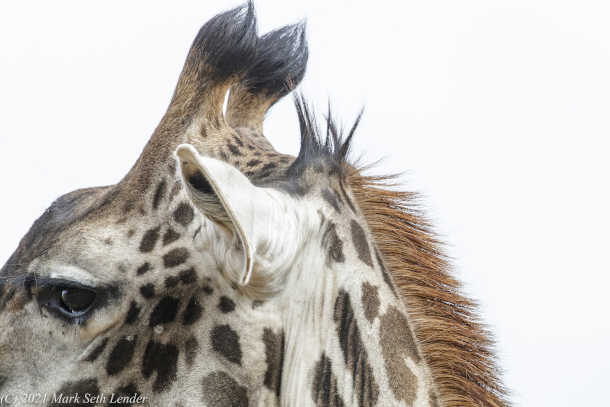Field Note: The Agreement - Maasai Giraffe in the Highlands of Kenya
Published: October 1, 2021
By Mark Seth Lender

A giraffe leans in for a tasty commiphora leaf snack. (Photo: (c) Mark Seth Lender)
Living on Earth's Explorer-in-Residence Mark Seth Lender recalls the first time he saw a giraffe in the wild, and comments on the value of their wildness and the threats they face.
When close to giraffe I always think about their feet, the mechanical advantage of those long legs, and what it would mean to be kicked. Notwithstanding, the temptation to come even closer is overwhelming. Giraffe are among the most beautiful things on earth.
The first wild animal I saw in Africa was a giraffe. Those small blunt tufted horns and that quizzical face popping up over the trees to have a look at us as we drove the narrow dirt track through the forest towards what would be our first camp. I will never forget it. Nor the Africa that opened up to me day by day, lush, wide, endless, and the presumption that all this life which from a human perspective has always been, would always be. I had come home. Many people feel it and remark upon it. These impressions, the sense of continuity they confer lead us the right way but do not foretell the future.
Giraffe habitat is being eaten up by fences and the giraffe themselves slaughtered for their meat, their skins, their body parts. Not out of hunger but for money. Big money. Made in sales of this atrocity to the local rich but mostly, to the distant and even more indifferent rich of The Civilized West (thousands of parts are sold in the United States), as well as the Wealthy East, Near and Far. Not to mention Safari Club International and its ilk, people who shoot giraffe for “sport” and thereby perpetuate the objectification of life and make slaughter acceptable.

A close-up of a Maasai giraffe in Kenya. (Photo: (c) Mark Seth Lender)
There is a difference between a giraffe in a cage which is how most of us get to see one if we see one at all and giraffe in natural open space. Captive, the way they navigate among tall trees and in between branches, is lost to you. Their deceptively slow-motion run is lost to you. That softness which includes both their eyes and their physicality as they walk from place to place with economy and grace, that you may never see.
Knowing they are “Out There” makes a difference.
When they no longer exist that will make a difference also.
Back to Mark Seth Lender Field Notes
Links
Living on Earth wants to hear from you!
Living on Earth
62 Calef Highway, Suite 212
Lee, NH 03861
Telephone: 617-287-4121
E-mail: comments@loe.org
Newsletter [Click here]
Donate to Living on Earth!
Living on Earth is an independent media program and relies entirely on contributions from listeners and institutions supporting public service. Please donate now to preserve an independent environmental voice.
NewsletterLiving on Earth offers a weekly delivery of the show's rundown to your mailbox. Sign up for our newsletter today!
 Sailors For The Sea: Be the change you want to sea.
Sailors For The Sea: Be the change you want to sea.
 The Grantham Foundation for the Protection of the Environment: Committed to protecting and improving the health of the global environment.
The Grantham Foundation for the Protection of the Environment: Committed to protecting and improving the health of the global environment.
 Contribute to Living on Earth and receive, as our gift to you, an archival print of one of Mark Seth Lender's extraordinary wildlife photographs. Follow the link to see Mark's current collection of photographs.
Contribute to Living on Earth and receive, as our gift to you, an archival print of one of Mark Seth Lender's extraordinary wildlife photographs. Follow the link to see Mark's current collection of photographs.
 Buy a signed copy of Mark Seth Lender's book Smeagull the Seagull & support Living on Earth
Buy a signed copy of Mark Seth Lender's book Smeagull the Seagull & support Living on Earth

